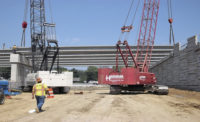After sitting out much of the nation's economic recovery, the construction industry in hard hit states such as Illinois, Wisconsin and Michigan began to see conditions ease this year, stemming the flow of job losses that curtailed thousands of workers year in and year out. Industry members in manufacturing-rich Indiana and Ohio, both star performers earlier in the recovery, weren't as lucky, as global demand for manufactured products slowed and construction job losses mounted.

In year over year comparisons, industry job losses in the two states ranked among the highest in the nation this year, according to data compiled by Arlington, Va.-based Associated General Contractors of America (AGC).
Look for the region's nonresidential sector to enjoy more uniformly positive growth next year, with a projected 7% increase mirroring that of the nonresidential sector nationwide, says Anirban Basu, chief economist with Arlington, Va.-based Associated Builders and Contractors (ABC).
"Conditions won't come near to matching those seen prior to the recession, but will show more promise than in 2013, which, at best, was flat, with gains in private construction offset by losses in the public sector," Basu says.
Ken Simonson, AGC chief economist, isn't as optimistic about prospects for the Midwest, but he says renewed global demand should signal additional gains in the region. "Prospects for manufacturing have improved relative to the erosion the region has seen in past decades," he says.
As demand for U.S. products accelerates, Ohio and Indiana once again will emerge as beneficiaries, as will industry members allied with manufacturing and distribution as well as related infrastructure, including road and bridge work.
"The entire manufacturing/distribution complex stands to benefit, including segments involved in agriculture," says Basu. "High-growth states such as Florida may have more consumers, but Midwest states are the producers of what they consume."
The problem, says Simonson, is that the Midwest has failed to develop as a center for high-growth industries, including high-tech and Internet-based enterprises. Despite modest success in eastern Ohio, the region also isn't poised to capitalize on shale-based natural gas.
"Illinois, Michigan and Indiana all hold the potential for exploiting shale, but it's a question of how accessible drillers think it is and whether they believe natural gas prices are favorable to proceed," Simonson says.


Post a comment to this article
Report Abusive Comment